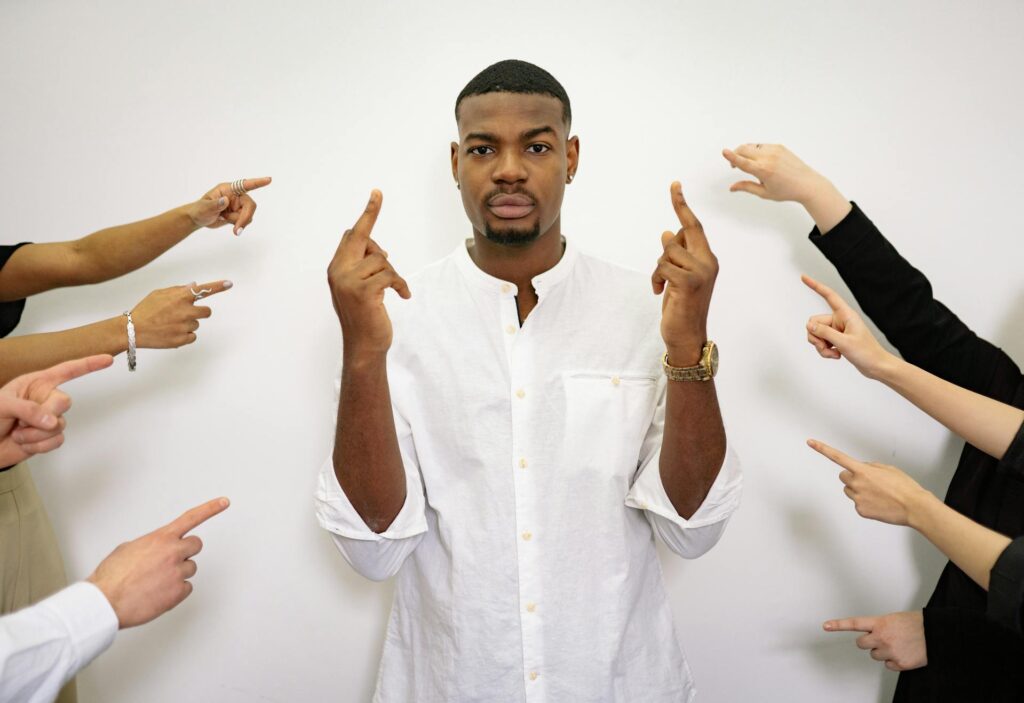Social Biases and Stereotypes
Social biases and stereotypes are pervasive, influencing our perceptions and interactions in profound ways. These biases are not merely abstract concepts; they manifest in real-world scenarios, shaping everything from hiring decisions to criminal justice outcomes.
- The Mechanics of Social Categorization:
Human cognition is inherently efficient, relying on categorization to manage the overwhelming influx of information. When we encounter a new individual, our brains rapidly assess various social cues—race, gender, age, attire, accent—and place them into pre-existing categories. This process is automatic and often unconscious.
- In-group/Out-group Bias: A fundamental aspect of social categorization is the tendency to favor our in-group (the groups we belong to) over out-groups (those we don’t). This bias stems from evolutionary roots, where distinguishing “us” from “them” was crucial for survival. Studies have shown that even arbitrary group assignments can trigger in-group favoritism.
- Intersectionality: It’s crucial to recognize that social categories are not isolated. Individuals belong to multiple groups simultaneously, and these identities intersect to create unique experiences. For example, the experiences of a Black woman differ from those of a white woman or a Black man. Intersectionality highlights the complexity of social bias and the need for nuanced understanding.
- Social Identity Theory: This theory posits that individuals derive part of their self-esteem from their group memberships. Therefore, they are motivated to perceive their in-groups positively and out-groups negatively.
- The Genesis of Social Biases:
Social biases are not innate; they are learned through socialization.
- Family Influences: Early childhood is a critical period for bias acquisition. Children absorb the attitudes and beliefs of their parents and caregivers, often without conscious awareness. Prejudiced remarks or subtle cues can shape a child’s worldview.
- Peer Group Dynamics: As individuals enter adolescence, peer groups become increasingly influential. Social acceptance often hinges on conforming to group norms, including shared biases.
- Media Portrayals: Media representations play a significant role in perpetuating stereotypes. Television, movies, and social media often depict stereotyped images of marginalized groups, reinforcing existing biases. For example, the underrepresentation of certain groups in positions of power can reinforce the idea that they are less capable.
- Institutional Biases: Social biases are embedded within societal structures, including educational, legal, and economic systems. These institutional biases can lead to systemic discrimination, where certain groups are systematically disadvantaged.
- Historical context: Biases are deeply ingrained in historical context. The legacy of slavery, colonialism, and other forms of oppression continues to shape contemporary social biases.
- The Insidious Nature of Implicit Bias:
Implicit biases operate outside of conscious awareness, making them particularly difficult to address.
- Implicit Association Test (IAT): The IAT is a widely used tool for measuring implicit biases. It reveals unconscious associations between concepts (e.g., race, gender) and evaluations (e.g., good, bad). Studies using the IAT have demonstrated that even well-intentioned individuals often harbor implicit biases.
- Microaggressions: These are subtle, often unintentional, forms of discrimination that communicate negative messages to marginalized groups. Microaggressions can take various forms, including verbal, nonverbal, and environmental.
- Real World examples:
- In hiring, resumes with “white-sounding” names often receive more callbacks than those with “black-sounding” names, even when qualifications are identical.
- Teachers may unconsciously hold lower expectations for students from marginalized backgrounds, affecting their academic performance.
- Racial profiling in law enforcement leads to disproportionate stops and arrests of people of color.
- In medicine, studies have indicated that doctors often treat the pain of black patients less seriously than the pain of white patients.
- Strategies for Dismantling Social Biases:
Combating social biases requires a multifaceted approach.
- Education and Awareness: Raising awareness of implicit biases and their impact is crucial. Educational programs can help individuals recognize their own biases and develop strategies for mitigating them.
- Intergroup Contact: Positive interactions between members of different groups can help to break down stereotypes and promote empathy. Contact must occur under equal status conditions, and with common goals.
- Diversity and Inclusion Initiatives: Creating diverse and inclusive environments in workplaces, schools, and communities is essential. Diversity training programs can help to foster understanding and respect.
- Counter-Stereotypical Imaging: Actively challenging stereotypical thinking by promoting counter-stereotypical examples. Media can play a vital role in showcasing diverse and positive representations of marginalized groups.
- Policy and Systemic Changes: Implementing policies that promote equality and combat discrimination is crucial. This includes affirmative action policies, anti-discrimination laws, and equitable resource allocation.
- Self-Reflection: Regularly engaging in self-reflection and examining our own biases is essential for personal growth.
- Perspective-Taking: Actively trying to understand the experiences of others from different backgrounds.

Cognitive Biases and Errors
Cognitive biases are systematic errors in thinking that influence our judgments and decisions. These biases stem from the brain’s reliance on heuristics, or mental shortcuts, to simplify complex information processing.
- The Role of Heuristics:
Heuristics are mental shortcuts that allow us to make quick decisions in everyday situations. While they are often helpful, they can also lead to systematic errors in judgment.
- Availability Heuristic: Estimating the likelihood of events based on how easily they come to mind. For example, people may overestimate the risk of plane crashes because they are more memorable than car accidents.
- Representativeness Heuristic: Judging the probability of an event based on how well it matches our prototypes. For example, we may assume that a quiet, studious person is more likely to be a librarian than a salesperson.
- Common Cognitive Biases:
- Confirmation Bias: The tendency to seek out and interpret information that confirms our existing beliefs, while ignoring or discounting contradictory evidence.
- Anchoring Bias: Relying too heavily on the first piece of information offered (the “anchor”) when making decisions.
- Framing Effect: How information is presented influences decision-making. For example, people are more likely to choose a product labeled “90% fat-free” than one labeled “10% fat.”
- Overconfidence Bias: Having an inflated sense of one’s own abilities, leading to poor decision-making.
- Hindsight Bias: The tendency to believe, after learning an outcome, that one would have foreseen it.
- Attribution Bias: How we explain the behavior of ourselves and others. For example, we may attribute our own successes to internal factors (e.g., skill) and our failures to external factors (e.g., bad luck).
- Dunning-Kruger Effect: This is where people with low ability at a task overestimate their ability, and people with high ability underestimate their ability.
- Loss aversion: people tend to heavily prefer avoiding losses to acquiring gains.
- Status quo bias: The tendency to prefer things to stay relatively the same.
- The Neurological Basis of Cognitive Biases:
Cognitive biases are rooted in the brain’s structure and function.
- Dual-Process Theory: This theory proposes that our brains operate on two systems: System 1, which is fast, automatic, and emotional, and System 2, which is slow, deliberate, and logical. Cognitive biases often arise from the dominance of System 1 thinking.
- Emotional Influences: Emotions can significantly influence our judgments and decisions. For example, fear can lead to risk-averse behavior, while anger can lead to impulsive decisions.
- Limited Processing Capacity: The brain’s limited processing capacity leads it to rely on heuristics, which can lead to errors.
- The Consequences of Cognitive Biases:
Cognitive biases can have significant consequences in various domains.
- Financial Decisions: Leading to risky investments and poor financial planning.
- Medical Decisions: Contributing to misdiagnosis and inappropriate treatment.
- Legal Decisions: Affecting judgments in court cases.
- Political Decisions: Influencing voting behavior and policy choices.
- Personal relationships: Biases can cause misunderstandings, and misinterpretations.
- Strategies for Mitigating Cognitive Biases:
- Awareness: Recognizing our own biases is the first step.
- Critical Thinking: Developing critical thinking skills to evaluate information objectively.
- Seeking Diverse Perspectives: Actively seeking out different viewpoints.
- Data-Driven Decision-Making: Relying on data and evidence rather than intuition.
- Slowing Down: Taking time to reflect on decisions and avoid rushed judgments.
- Structured Decision Making: Using methods such as checklists, and algorithms.
- Consider the opposite: Actively think of reasons that your current opinion is wrong.
- Outside views: Ask for the opinion of someone that has a different view than your own.
- The Evolutionary Purpose of Biases:
While biases can cause problems, they have also served evolutionary purposes.
- Quick Decisions: Quick decisions, although sometimes inaccurate, could be the difference between life and death in past times.
- Social Cohesion: The brains ability to quickly categorize people into “in groups” and “out groups” could also have helped early humans to survive.

Free consultations. Connect free with local health professionals near you.
Conclusion
The intricate interplay between social biases and cognitive errors forms a formidable challenge to individual and societal well-being. As we’ve explored, social biases, rooted in learned prejudices and stereotypes, perpetuate inequalities and hinder genuine human connection. Operating often implicitly, they subtly shape our perceptions and actions, influencing everything from hiring decisions to everyday interactions. Meanwhile, cognitive errors, the inherent flaws in our thought processes, lead us astray with their seductive shortcuts and distorted realities. These mental traps, like confirmation bias and the availability heuristic, skew our judgments and undermine rational decision-making.
The convergence of these forces creates a complex web of misperceptions and injustices. Social biases, amplified by cognitive errors, reinforce stereotypes and perpetuate discriminatory practices. For instance, the availability heuristic can lead to overestimating the prevalence of negative behaviors in marginalized groups, thus strengthening existing prejudices. Similarly, confirmation bias can cause us to selectively interpret information to fit our pre-existing social biases, ignoring contradictory evidence.
The ramifications of these biases extend beyond individual interactions, permeating the very fabric of our institutions. From the courtroom to the boardroom, from the classroom to the doctor’s office, biased judgments and flawed reasoning can have profound consequences. They contribute to systemic inequalities, erode trust in public institutions, and stifle progress towards a more just and equitable society.
However, awareness is the first and most critical step toward mitigation. Recognizing the ubiquitous nature of these biases—both within ourselves and in the systems we inhabit—is essential. We must cultivate a culture of self-reflection, actively challenging our assumptions and seeking out diverse perspectives. Education plays a pivotal role, empowering individuals with the tools to identify and counteract biased thinking.
Furthermore, systemic change is indispensable. Policies that promote diversity, inclusion, and equity are crucial for dismantling the structures that perpetuate bias. We must strive to create environments where diverse voices are valued, and where decisions are based on evidence and fairness, not prejudice and flawed intuition.
The journey toward a less biased world is ongoing and requires sustained effort. It demands a commitment to continuous learning, critical thinking, and empathy. By acknowledging our inherent fallibilities and actively working to counteract them, we can pave the way for a more just, rational, and compassionate society.
Time to feel better. Find a mental, physical health expert that works for you.
Common FAQs:
Social Biases:
What is the difference between bias and prejudice?
Bias is a tendency, inclination, or prejudice toward or against something. Prejudice is a preconceived judgment or opinion, often negative, that is not based on reason or actual experience. Bias can lead to prejudice, but not always.
Are all biases negative?
While many biases have negative consequences, some can be neutral or even seemingly positive. However, even “positive” biases can lead to unfairness and unequal treatment.
How do I know if I have implicit biases?
Implicit biases are often unconscious. You can take implicit association tests (IATs) online to explore your potential biases, though these tests are not perfect. Self-reflection and paying attention to your reactions to different groups can also be helpful.
Can I completely eliminate my social biases?
It’s difficult to eliminate biases entirely, as they are often deeply ingrained. However, you can significantly reduce their impact by increasing awareness, actively challenging stereotypes, and promoting inclusive behaviors.
How does the media contribute to social biases?
The media often portrays stereotypical images of various groups, which can reinforce and perpetuate biases. Limited representation and biased narratives can also contribute to negative perceptions.
What is microaggression?
Microaggressions are subtle, often unintentional, verbal or nonverbal slights or insults that communicate negative messages to marginalized groups.
Cognitive Errors:
What are cognitive biases, and why do we have them?
Cognitive biases are systematic errors in thinking that influence our judgments and decisions. We have them because our brains use mental shortcuts (heuristics) to simplify complex information processing.
How does confirmation bias affect decision-making?
Confirmation bias leads us to seek out and interpret information that confirms our existing beliefs, while ignoring or downplaying contradictory evidence, resulting in skewed decisions.
What is the availability heuristic, and how does it work?
The availability heuristic is a mental shortcut where we estimate the likelihood of events based on how easily they come to mind. Vivid or recent events are more likely to be recalled, leading to overestimations of their frequency.
Can I overcome cognitive biases?
While you can’t eliminate them entirely, you can mitigate their impact by increasing awareness, using critical thinking, seeking diverse perspectives, and relying on data-driven decision-making.
How does emotional state influence cognitive biases?
Emotional states can significantly influence cognitive biases. For example, fear can amplify the availability heuristic, making us overestimate the likelihood of negative events.
What are some practical ways to reduce the impact of cognitive biases in daily life?
Slow down your decision-making, actively seek out opposing viewpoints, consider alternative explanations, and use structured decision-making processes.
How do cognitive biases affect financial decisions?
Cognitive biases such as overconfidence and loss aversion can lead to poor investment choices and financial risks.
NOTICE TO USERS
MindBodyToday is not intended to be a substitute for professional advice, diagnosis, medical treatment, or therapy. Always seek the advice of your physician or qualified mental health provider with any questions you may have regarding any mental health symptom or medical condition. Never disregard professional psychological or medical advice nor delay in seeking professional advice or treatment because of something you have read on MindBodyToday.
Share this article

Let us know about your needs so we can answer any of your questions.

Fast and easy to understand quote

We come fully prepared.Hire when ready.
Popular Professionals Near You
You might also like
Emotional Intelligence
, What is Emotional Intelligence? Everything you need to know Find a Pro Emotional Intelligence: Origins The ascent of emotional […]
All About Emotional Contagion
, All About Emotional Contagion FIND LICENSE A PROFESSION Emotional Resonance in Relationships Emotional resonance, a profound and often subconscious […]
All About Emotional Abuse
, All About Emotional Abuse Find a license Pro Recognizing and Overcoming Emotional Abuse Emotional abuse, a silent epidemic, infiltrates […]





